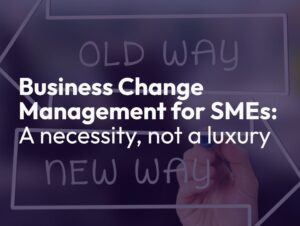These recommendations highlight the importance of adopting a deliberate, structured, and tailored approach when managing organisational transformation, particularly in addressing the human element of change.
For leaders, it’s vital to ensure that our hybrid and remote teams feel genuinely heard. When organisations adopt a heavily process-driven, systematic approach, communication can easily become diluted—turning into a frustrating game of telephone ping pong.
In our work with organisations undergoing transformation, we’ve frequently encountered situations where leadership is fixated on discussing workstreams, processes, structures, and systems, often neglecting the people at the heart of it all. This oversight leaves teams feeling disconnected and asking, “Why is this happening?”
1. Maintain focus on the “why”
Effective change management starts with a strong emphasis on the “why.” Leaders must recognise that change evokes an emotional response—people are not machines; they want to understand the reasons behind disruption, especially when it affects their day-to-day roles. Taking the time to communicate the rationale clearly ensures alignment and trust within the team.
2. Align your messaging
Consistency is key. For change to be well-received, all leaders and people managers must deliver a unified message. A shared narrative fosters clarity and creates a cohesive understanding across the organisation, which is crucial for effective change management.
3. Incorporate change responses into leadership training
Equip leaders with the tools to handle a range of emotional and behavioural responses to change. By embedding this into leadership development, organisations can turn potential resistance into an opportunity to enhance leadership capability. With a confident, unified, and empathetic approach, managers can help their teams become more resilient and adaptable.
4. Pay close attention to behaviour
Understanding behavioural responses is fundamental to effective change management. Be mindful of the subtle signs of fear or resistance. Address unspoken concerns and clarify any confusing language. Clear, transparent, and regular communication reassures teams and builds confidence.
5. Harness the power of storytelling
Storytelling is a powerful tool in managing change. While data appeals to logic, stories speak to emotion. Use real-life examples and scenarios to show how the change will benefit both the team and individuals. This human-centred approach can be more persuasive than numbers alone. Explore our creative PowerPoints at Good Change People to help communicate your key messages, status updates, and project milestones in a compelling way.
6. Create space for team expression
Encourage open dialogue by providing safe spaces where employees can express their concerns, ask questions, and share their perspectives. Proactively schedule conversations around change to keep doubts from festering and to promote early engagement and ownership.
7. Provide a controllable team purpose
Amid uncertainty, offer your team something tangible to focus on—such as a shared goal or meaningful project. Providing this focal point can anchor the team and offer reassurance, even when external variables feel overwhelming. It’s a small but powerful way to strengthen team cohesion during transformation.
8. Emphasise opportunities for everyone
Even when change includes challenging steps like restructuring, it’s important to highlight new opportunities. Provide reassurance through access to training, development, or qualification programmes. This demonstrates your commitment to employee growth and helps the team see the value in change.
9. Be responsive to ongoing change
Don’t become so absorbed in implementation that you lose sight of your people. Effective change management requires continuous assessment. Use tools such as pulse checks to monitor how the change is being received, identify areas of friction, and adapt your approach where needed.
10. Live the change
Leaders must model the change they want to see. Align your words with your actions, and be a visible advocate for the new direction. When leaders embody the change—through behaviour, language, and use of tools—they reinforce confidence and credibility. Believing in the change, behaving accordingly, and championing the process are all key components of effective change management.





